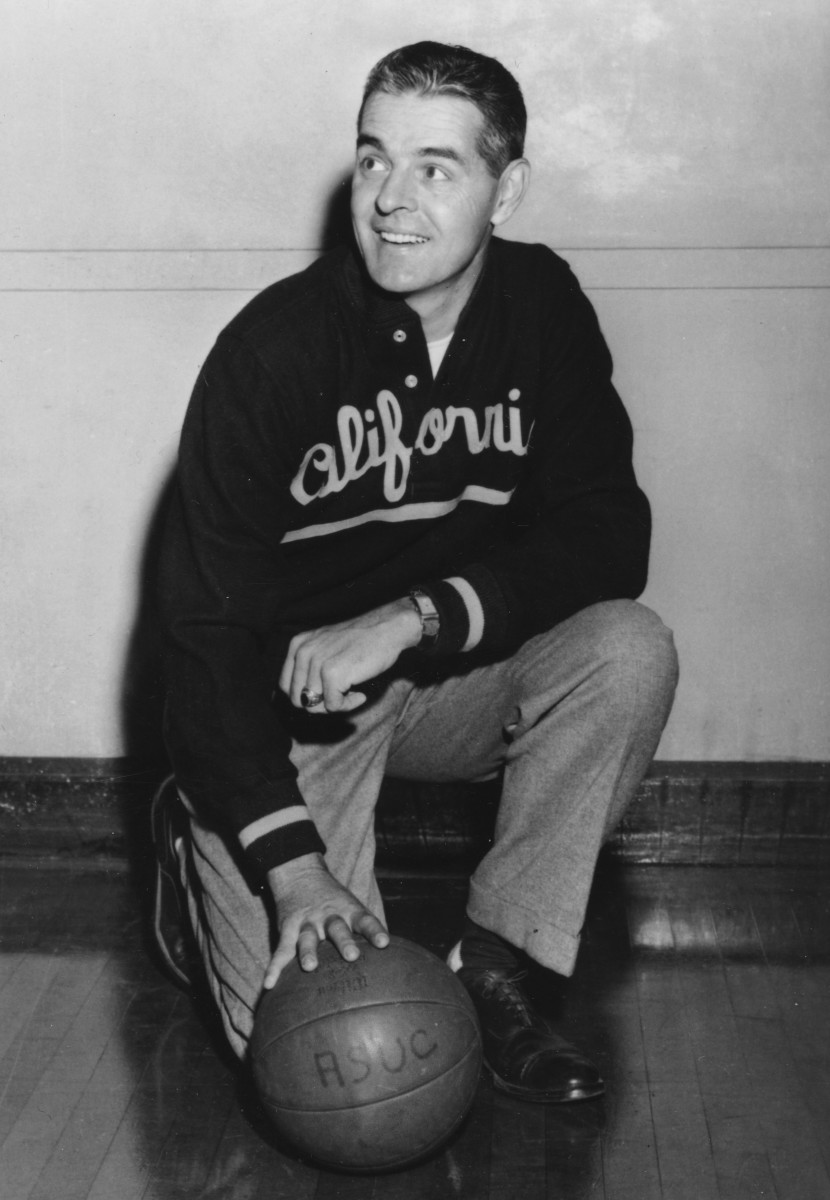The Cal 100: No. 4 -- Pete Newell
We count down the top 100 individuals associated with Cal athletics, based on their impact in sports or in the world at large – a wide-open category. See if you agree.
No. 4: Pete Newell
Cal Sports Connection: Newell coached Cal basketball for six seasons, winning four conference titles and leading the Bears to the NCAA tournament each of those seasons. His 1959 team won the national championship and his final team in 1960 made it back to the Final Four.
Claim to Fame: Newell coached the 1960 Olympic team to a gold medal then went on to become athletic director at Cal and general manager for the Lakers, where he executed a trade to get Kareem Abdul-Jabbar. He also operated his big man's camp for a quarter-century, teaching low-post skills and footwork to players such as Bill Walton and Shaquille O'Neal.
.
Pete Newell coached the USF basketball team to the 1949 NIT title when that tournament mattered. He led Cal to the 1959 NCAA championship and a return trip to the Final Four in 1960. That same year, he guided Jerry West, Oscar Robertson and the U.S. Olympic team to a gold medal in Rome.
But Newell, who is No. 4 in The Cal 100, was more than a coach. Much more.
He was Cal’s athletic director for eight years. He was the Los Angeles Lakers’ general manager who traded for Kareem Abdul-Jabbar. He served on the NCAA tournament selection committee and twice was chair of the U.S. Olympic team selection committee.
He wrote basketball instructional manuals and spent 11 years as an adviser to the Peace Corps’ worldwide basketball program.
Above all else, Pete Newell was a teacher.

For more than a quarter-century, Newell ran his Big Man’s Camp in Honolulu or Las Vegas, where he taught low-post skills and footwork. Later he conducted the Pete Newell Tall Women’s Basketball Camp in Monterey.
His most famous pupils included some of the game’s biggest stars: Bill Walton, Hakeem Olajuwon, Bernard King, Scottie Pippen, James Worthy.
"He's the best teacher there is,” said Shaquille O’Neal, another Newell camper.
Long-time NBA coach Rick Carlisle, who worked Newell’s camp, said the experience was invaluable to players.
"The chance to spend a week with Pete Newell is like a student of literature getting to spend a week with Hemingway or Frost,” Carlisle once said. “The man is the greatest treasure we have in our sport. He is the godfather of modern basketball.”
“There’s nobody like Pete,” former Cal coach Ben Braun once said. “He's the greatest teacher I've ever been around.”
In the 1950s, while still an active coach, Newell reportedly spoke at more basketball clinics throughout the country than anyone. He presented basketball seminars in Europe and Central and South America.
For two decades he volunteered to help develop the sport in Japan, including working with their Olympic program. In 1987, Japan’s emperor awarded Newell the Order of the Sacred Treasure, an honor never before given to a coach.
Former Indiana coach legend Bob Knight, who in temperament and reputation could not be more different than Newell, was a close friend.

"Three coaches had the most influence on college basketball in terms of tactics, both offensively and defensively: Clair Bee, Hank Iba and Pete. And I think Pete had the greatest total grasp,” Knight said. “He really studied it and kept abreast of it, both professional and collegiate. He was truly remarkable.
"Nobody contributed more to this game and its history than Pete Newell.”
The more than six-decade span of Newell’s basketball life stretched from Hank Luisetti, the late 1930s Stanford star who created the one-handed shot, to Yao Ming, China’s remarkable 7-foot-6 center.
Born in Vancouver, B.C. in 1915, Newell grew up in Los Angeles, where his mother prompted him to become a child actor. He appeared in several “Our Gang” movie comedies and was considered for a role opposite Charlie Chaplin in “The Kid” in 1920 before Jackie Coogan got the part.
That was just fine with young Pete. "I hated acting," he said. "All I wanted to do was to be home playing ball.”
He played basketball at what is now called Loyola Marymount, then coached at a military academy and played one season of minor-league baseball in the Brooklyn Dodgers' organization before a four-year stint in the Navy during World War II.
As coach at USF, he compiled a record of 70-37 in four seasons, including 25-5 in 1948-49 when the Dons reached as high as No. 6 in the AP Top-25 and won the NIT. Newell followed that with a 45-41 record at Michigan State over four seasons through 1953-54.
Cal had played in the NCAA tournament just once before Newell arrived, but the Bears made it four seasons in a row starting in 1957, his third year at the helm. Newell’s teams employed an aggressive defense, including a full-court zone press, and a disciplined offense. He is credited with developing the four corners offense, later used effectively by North Carolina’s Dean Smith.
The Bears were 119-44 in Newell’s six seasons, including 93-20 with four conference titles his final four years. Newell won his last eight head-to-head matchups with UCLA’s John Wooden.

The 1959 team, led by Darrall Imhoff, Denny Fitzpatrick and Al Buch, beat Robertson and Cincinnati 64-58 in the national semifinals and West and West Virginia 71-70 in the title game at Louisville, finishing the season 25-4.
The Bears made it back to the Final Four a year later, again beating three-time national player of the year Robertson and his teammates in the semifinals at the Cow Palace outside San Francisco. But they were overpowered 75-55 in the championship game by an Ohio State team led by future NBA star Jerry Lucas.
Cal finished the season 28-2 and Newell was named national coach of the year, then retired at the urging of his doctor. He was just 44.
"It was my health," Newell said years later. "I was carrying it all inside. I was smoking too many cigarettes, drinking too much coffee, and wasn't able to eat. I wouldn't eat anything from Thursday to Saturday.”
He also told sports writer Bruce Jenkins he wasn’t comfortable being in the spotlight. “It goes way back to my early days as a kid, when I hated everything that came with being an actor,” he said in Jenkins’ 1999 biography, A Good Man. “Obviously, my health was the major thing. But toward the end there, the whole experience was kind of chokin’ me.”
Newell’s 1960 Olympic team, featuring 10 future NBA players including Robertson, West, Lucas and Walt Bellamy, beat eight straight opponents by an average margin of more than 40 points to win in Rome.
He never coached another team, but his connection to the game — most often as a teacher — remained strong for nearly another half-century.
The Pete Newell Challenge, a college basketball doubleheader at the Oakland Coliseum Arena, attracted teams including North Carolina, Duke, Indiana, Kansas, Michigan and Gonzaga over 10 years. Cal’s playing surface at Haas Pavilion is named Pete Newell Court.
Newell was inducted into the Naismith Hall of Fame as a contributor in 1979 and with his ’60 Olympic team in 2010. He also has a hall of fame place at Cal, USF and Loyola and in 1984 was voted into the Bay Area Sports Hall of Fame.
Former Cal player Dick Doughty said he and his teammates forever appreciated what Newell did for them.
"Nobody had a more important impact on our lives," Doughty told ESPN the Magazine. "Not in basketball — in life. As we grew up and matured, we were even more in awe of what he was able to do with us.”
Newell died in 2008 at the age of 93.
Cover photo of Pete Newell courtesy of Cal Athletics
Follow Jeff Faraudo of Cal Sports Report on Twitter: @jefffaraudo
